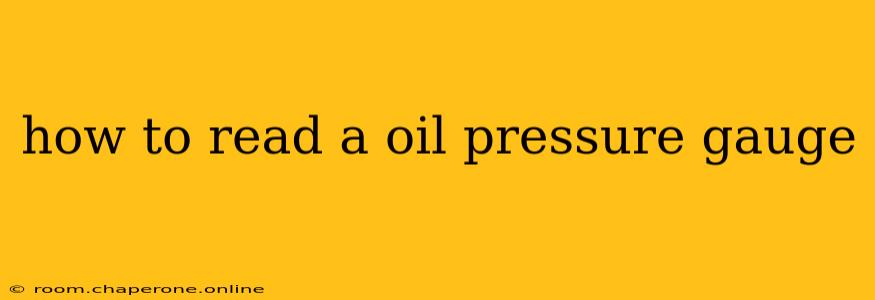Understanding your vehicle's oil pressure gauge is crucial for maintaining engine health and preventing costly repairs. This guide provides a comprehensive overview of how to read an oil pressure gauge, interpret its readings, and understand what action to take based on different readings.
Understanding the Basics of Oil Pressure
Before diving into how to read the gauge, let's establish the fundamental role of oil pressure in your engine. Engine oil acts as a lubricant, reducing friction between moving parts. Oil pressure ensures this lubricant reaches all critical components, preventing wear and tear. Insufficient oil pressure can lead to catastrophic engine damage.
Deciphering Your Oil Pressure Gauge
Oil pressure gauges typically display pressure in pounds per square inch (PSI) or as a simple visual indicator (e.g., a needle moving across a scale or a series of lights). Here's a breakdown of how to interpret the most common types:
1. Needle Gauge:
-
Normal Operating Range: Most vehicles operate optimally within a range of 15-50 PSI at idle and slightly higher at higher engine speeds. Check your owner's manual for the specific recommended range for your vehicle model. The exact numbers will vary depending on the engine, temperature, and the type of oil used. The gauge itself usually provides visual cues indicating the normal operational range.
-
Low Oil Pressure: A needle that consistently reads below the minimum range (often indicated by a red zone on the gauge) signifies low oil pressure. This is a serious issue that requires immediate attention.
-
High Oil Pressure: While less common, excessively high oil pressure (significantly above the maximum range) can also indicate problems, such as a faulty pressure relief valve.
-
Fluctuating Needle: A needle that jumps erratically between high and low readings could signal several problems including a failing oil pump, clogged oil filter, or low oil level.
2. Warning Light Gauge:
Some vehicles utilize a simpler warning light system instead of a needle gauge.
-
Light Off: A light that remains off indicates normal oil pressure.
-
Light On: A light that illuminates suggests low oil pressure. This warrants immediate attention – pull over safely and turn off the engine.
What to Do Based on Your Reading
Low Oil Pressure:
-
Immediate Action: If your gauge indicates low oil pressure (needle in the red or warning light illuminated), stop driving immediately. Continuing to operate the engine could cause significant damage.
-
Possible Causes: Low oil level, faulty oil pump, clogged oil filter, or a leak in the oil system.
-
Troubleshooting: Check your oil level using the dipstick. If low, add oil. If the problem persists, have your vehicle inspected by a qualified mechanic.
High Oil Pressure:
-
Investigation Required: While less critical than low oil pressure, persistently high readings should not be ignored.
-
Possible Causes: A faulty pressure relief valve or excessively thick oil.
-
Professional Diagnosis: Have your vehicle examined by a mechanic for proper diagnosis and repair.
Fluctuating Oil Pressure:
-
Serious Concern: Fluctuations indicate potential problems within the lubrication system.
-
Professional Attention: This requires prompt professional attention to diagnose the underlying cause.
Maintaining Optimal Oil Pressure
Regular maintenance is key to maintaining healthy oil pressure. This includes:
-
Regular Oil Changes: Follow your vehicle's recommended oil change intervals.
-
Using the Correct Oil: Use the type and weight of oil specified in your owner's manual.
-
Checking Oil Level Regularly: Check your oil level frequently using the dipstick.
Conclusion
Understanding how to interpret your oil pressure gauge is essential for maintaining your vehicle's engine health and longevity. By paying attention to the gauge readings and taking appropriate action, you can prevent costly repairs and ensure your engine performs reliably for years to come. Always consult your owner's manual for specific recommendations and ranges for your vehicle. If you are uncertain about any readings or required actions, seek the advice of a qualified mechanic.

